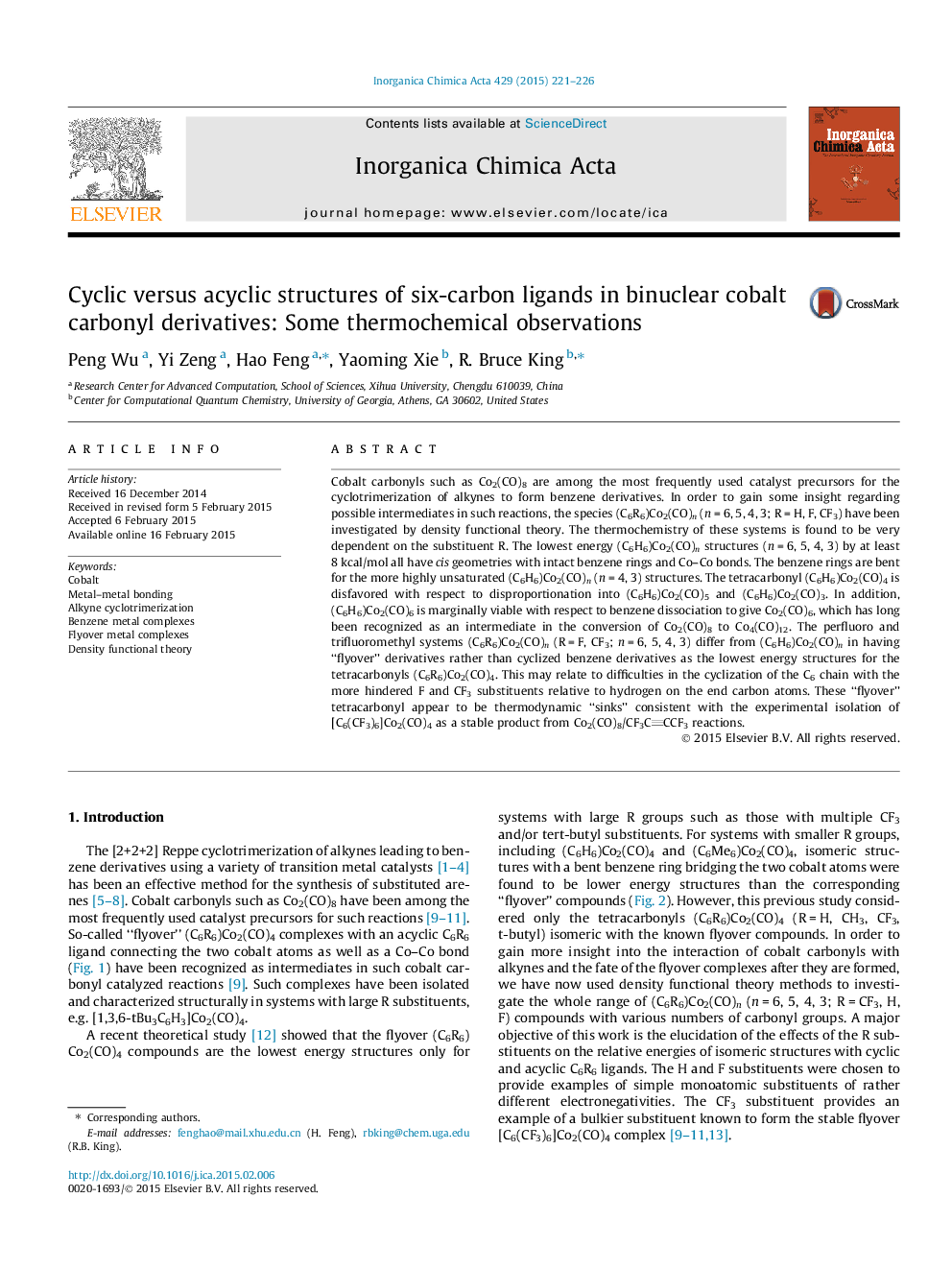| کد مقاله | کد نشریه | سال انتشار | مقاله انگلیسی | نسخه تمام متن |
|---|---|---|---|---|
| 1306628 | 1499160 | 2015 | 6 صفحه PDF | دانلود رایگان |
• (C6R6)Co2(CO)n (n = 6, 5, 4, 3; R = H, F, CF3) have been investigated by density functional theory.
• (C6H6)Co2(CO)n (n = 6, 5, 4, 3) all have intact benzene rings and Co–Co bonds as the lowest energy structures.
• The benzene rings are bent in (C6H6)Co2(CO)n (n = 4, 3).
• (C6R6)Co2(CO)4 (R = F, CF3) have acyclic “flyover” derivatives as the lowest energy structures.
Cobalt carbonyls such as Co2(CO)8 are among the most frequently used catalyst precursors for the cyclotrimerization of alkynes to form benzene derivatives. In order to gain some insight regarding possible intermediates in such reactions, the species (C6R6)Co2(CO)n (n = 6, 5, 4, 3; R = H, F, CF3) have been investigated by density functional theory. The thermochemistry of these systems is found to be very dependent on the substituent R. The lowest energy (C6H6)Co2(CO)n structures (n = 6, 5, 4, 3) by at least 8 kcal/mol all have cis geometries with intact benzene rings and Co–Co bonds. The benzene rings are bent for the more highly unsaturated (C6H6)Co2(CO)n (n = 4, 3) structures. The tetracarbonyl (C6H6)Co2(CO)4 is disfavored with respect to disproportionation into (C6H6)Co2(CO)5 and (C6H6)Co2(CO)3. In addition, (C6H6)Co2(CO)6 is marginally viable with respect to benzene dissociation to give Co2(CO)6, which has long been recognized as an intermediate in the conversion of Co2(CO)8 to Co4(CO)12. The perfluoro and trifluoromethyl systems (C6R6)Co2(CO)n (R = F, CF3; n = 6, 5, 4, 3) differ from (C6H6)Co2(CO)n in having “flyover” derivatives rather than cyclized benzene derivatives as the lowest energy structures for the tetracarbonyls (C6R6)Co2(CO)4. This may relate to difficulties in the cyclization of the C6 chain with the more hindered F and CF3 substituents relative to hydrogen on the end carbon atoms. These “flyover” tetracarbonyl appear to be thermodynamic “sinks” consistent with the experimental isolation of [C6(CF3)6]Co2(CO)4 as a stable product from Co2(CO)8/CF3CCCF3 reactions.
The lowest energy (C6H6)Co2(CO)n structures (n = 6, 5, 4, 3) by at least 8 kcal/mol all have cis geometries with intact benzene rings and Co–Co bonds. However, the perfluoro and trifluoromethyl systems have “flyover” derivatives with acyclic rather than cyclic C6R6 ligands as the lowest energy structures for (C6R6)Co2(CO)n (n = 4, 3).Figure optionsDownload as PowerPoint slide
Journal: Inorganica Chimica Acta - Volume 429, 1 April 2015, Pages 221–226
